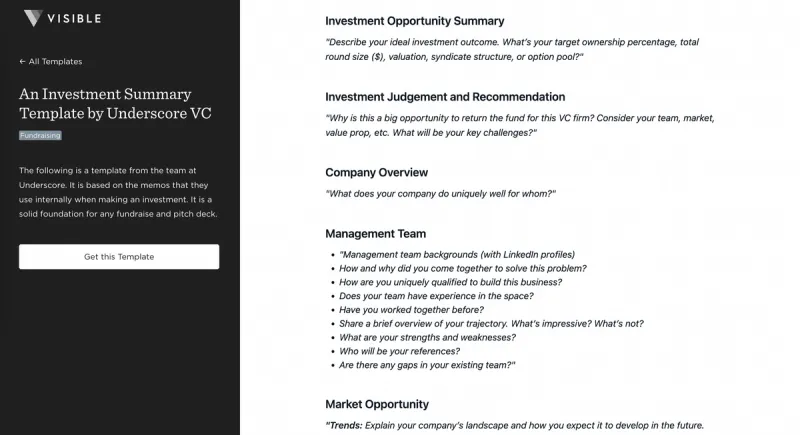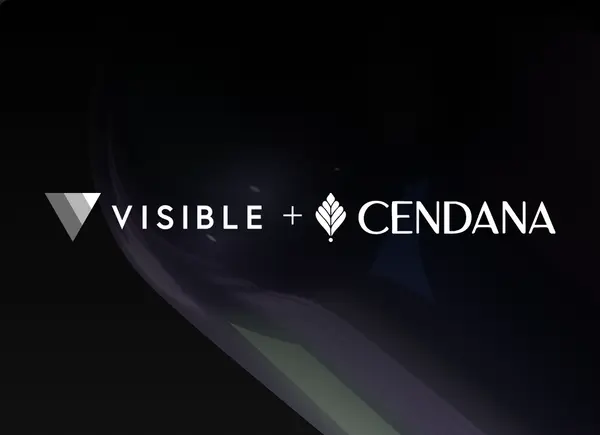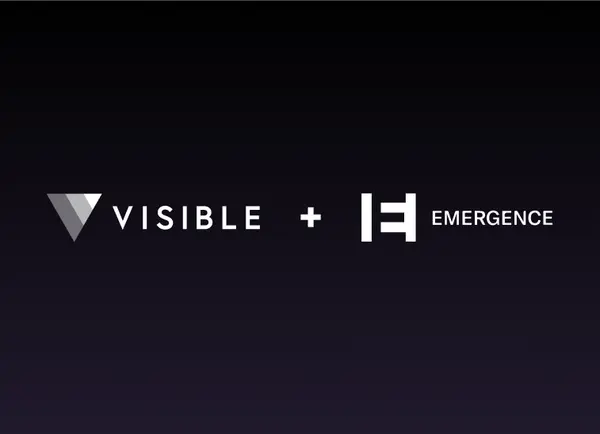Key Takeaways
-
Learn how to create a winning startup funding proposal that clearly communicates your vision, traction, and financial needs to investors.
-
Explore the key components every funding proposal must include, from performance metrics and market analysis to valuation and growth strategy.
-
Discover eight proven proposal and pitch templates, including examples from Underscore VC, Visible, and Morgan Stanley, to streamline your fundraising process.
-
Understand how to tailor your funding proposal format, traditional document, pitch deck, email, or data room, to engage investors effectively.
Being a founder is difficult. Managing the day-to-day as a founder while trying to secure capital for your business can almost feel impossible. Thankfully, there are different tools and techniques that founders can use to systemize their fundraise to focus on what truly matters, building their business.
One of those tools is a startup funding proposal. In this guide, we’ll break down what a startup funding proposal is and how you can leverage it to build momentum in your fundraise.

What Is a Startup Funding Proposal?
A startup funding proposal is a document that helps startup founders share an overview of their business and make the case for why they should receive funding. A startup funding proposal can be boiled down to help founders layout 3 things:
- What — what does your startup do
- How — how does your startup or product help customers accomplish what they are seeking
- Why — why does your startup need funding and why should an investor fund your business
Related Resource: How to Write a Business Plan For Your Startup
Types of Startup Funding Proposals
Like any business document, there are many ways to approach a startup funding proposal. Ultimately it will come down to pulling the pieces and tactics that work best for your business. Investors are seeing hundreds, if not thousands, of deals a month so it is important to have your assets buttoned up to move quickly and build conviction during a raise.
Check out a couple of popular types of funding proposals below:
Traditional Startup Funding Proposal
The most traditional or “standard” standard funding proposal is generally a written and visual document that is created using word processing software and/or design tools.
A traditional proposal is great because it allows you to share context with every aspect of your business. For example, if you include a chart of growth you’ll be able to explicitly write out why that was and what your plan is for future growth.
This document is generally designed to fit your brand and will hit on the key components of your business is structured and predictable way. We hit on what to include in your proposal below.
Startup Funding Proposal Pitch or Presentation
The most common approach we see to a fundraise or proposal is the pitch deck. Pitch decks take the same components as any proposal and fit them into a visual pitch deck that can be easily navigated and understood by a potential investor.
Pitch decks are not required by investors by are generally expected and are a great tool that can help you efficiently close your round. To learn more about building your pitch deck, check out a few of our key resources below:
- Tips for Creating an Investor Pitch Deck
- 18 Pitch Deck Examples for Any Startup
- Our Teaser Pitch Deck Template
1-on-1 Proposals (Elevator Pitch)
A 1 on 1 proposal or an elevator pitch is the quickest version of any proposal. Every founder should have an elevator pitch in their back pocket and is a complementary tool to any of the other funding proposals mentioned here.
As the team at VestBee puts it, “Elevator pitch” or “elevator speech” is a laconic but compelling introduction that can be communicated in the amount of time it takes someone to ride an elevator, usually around 30 seconds. It can serve you for fundraising purposes, personal introduction, or landing a prospective client.”
Email Proposal
Another common way to share a startup funding proposal via email. While the content might be similar to what is seen in a “traditional” funding proposal this allows you to hit investors where they spend their time – their inbox.
The format will follow a traditional proposal with less emphasis on visual aspects and more emphasis on the written content. Check out an example from our Update Template Library below:
Related Resource: How to Write the Perfect Investment Memo
Investor Relationship Hub
Lastly, there is an investor relationship hub or data room that can be used to share your proposal with potential investors. A hub is a great place to curate multiple documents or assets that will be needed during your fundraise. For example, you could share your funding proposal and your financials if they are requested by a potential investor.
Related Resource: What Should be in an Investor Data Room?
What to Include in Your Startup Funding Proposal
How you share your funding proposal might differ but ultimately the components are generally closely related from one proposal to the next. However, be sure that you are building this for your business. There is no prescriptive template that will work for every business.

Project Summary
First things first, you’ll want to start with a summary of your project or your business. This can be a high-level overview of what your proposal encompasses and will give an investor the context they need for the rest of the proposal. A couple of ideas that are worth hitting on:
- What your company does and how it’s different from existing solutions to pressing problems.
- Existing market gaps and how your product covers them.
- The importance of your product in your industry and how it improves the industry.
- Existing resources and manpower, investment requirements, and potential limitations.
Current Performance and Financial Report
Of course, investors want to see how your business has been performing. The data and metrics around your business are generally how an investor builds conviction and further interest in your business. We suggest using your best judgment when it comes to the level of metrics or financials that you’d like to share. A couple examples of what you might share:
- Current assets and liabilities
- MVP presentation for companies still in the ideation stage
- Appendix with financial reports
Related Resource: Building A Startup Financial Model That Works

Existing Investors and Partners
Inevitably investors will want to know who else you have raised capital from and partnered with in the past. Include a brief description of the different investors you have on your cap table and be ready to field additional questions if they have any.
Pro tip: The first place an investor will go to when performing due diligence is your current investors. Make sure you have a strong relationship and good communication with your current investors.
Market Study and Sales Goals
Investors will also care about your customer acquisition efforts and want to make sure you can repeatably find and close new customers. A couple of things that might be important to include in this section:
- Product pricing and information
- Revenue targets and goals
- Customer acquisition model and efforts
- Sales and marketing related KPIs
- Stories or testimonials from happy customers
Current Valuation, Investment Requirements, and Expected Returns
This is an opportunity to lay out your cap table, explain your current valuation, outline your investment requirements, and describe what future valuations could look like. As always, we suggest using your best judgment when deciding how much detail you’d like to share about your cap table.
Potential Pitfalls and Solutions
There is an inherent risk when investing in any startup. In fact, research shows that roughly 75% of venture-backed startups fail to deliver returns to investors, underscoring the importance of transparency around risks. Layout the common pitfalls your startup might face and stop you from achieving your goals. Next, lay out the solutions to these problems and how you plan to tackle them if/when they arise.
8 Startup Funding Proposal Samples and Templates
Below are 8 proposal templates to help you kick off your next fundraise. Note that some of these are technically investor updates and not designed for first-time fundraising. Keep in mind that a startup funding proposal could also be utilized for additional funding after the first round of funding.
1. An Investment Summary Template by Underscore VC

Underscore VC is a seed-stage venture fund based out of Boston. As the team at Underscore writes:
“As part of this, we strongly recommend you write out a pitch narrative before you start to build a pitch deck. “Writing the prose forces you to fill in the gaps that can remain if you just put bullets on a slide,” says Lily Lyman, Underscore VC Partner. “It becomes less about how you present, and more about what you present.”
This exercise can help you synthesize your thoughts, smooth transitions, and craft a logical, compelling story. It also helps you include all necessary information and think through your answers to tough questions.
Check out the template here.
2. The Visible “Standard” Investor Update Template
Our Standard investor update template is great for communicating with existing investors. If you are regularly sending Updates to their investors they should know when you are beginning to raise capital again and can almost be treated as an investment proposal.
Check out the template for our standard investor update template here.
3. Sharing a Fundraising Pitch via Video

Videos are a great way to give the right context to the right investors in a concise and quick way. Video is a great supporting tool for any other information or documents you might be sending over. For example, you can include a few charts or metrics and some company information and use the video to further explain the data and growth plans.
Check out the template here.
4. Financial Funding Proposal
The team at Revv put together a plug-and-play financial funding proposal. As they wrote, “A funding proposal must provide details of your company’s financials to obtain the right amount of funding. Check out our funding proposal template personalized for your business.”
Check out the template here.
5. Investor Proposal Template for SaaS Companies
The team at Revv put together a template to help founders grab the attention of investors. As they wrote, “With so many Investing Agencies, this Investor proposal will surely leave an impact on your company in the long run.”
Check out the template here.
6. Startup Funding Proposal Sample
Template.net has created a downloadable funding proposal template that can be edited using any tool. As they wrote, “Get your business idea off the ground by winning investors for your business through this Startup Investment Proposal. Fascinate investors with how you are going to get your business into the spotlight and explain in vivid detail your goals or target for the business.”
Check out the template here.
7. Simple Proposal Template
Best Templates has created a generic proposal template that can be molded to fit most use cases. As they wrote, “Use this Simple Proposal Template for any of your proposal needs. This 14-page proposal template is easily editable and fully customizable using any chosen application or program that supports MS Word or Pages file formats.”
Check out the template here.
8. Sample Investment Proposal for Morgan Stanley
Another example is from the team at Morgan Stanley. The template is commonly used by their team and can be applied to most proposal use cases.
Check out the template here.

Connect With More Investors and Tell Your Story With Visible
Being able to tie everything together and build a strategy for your fundraise will be an integral part of your fundraising success. Check out how Visible can help you every step of the way below:
Visible Connect — Finding the right investors for your business can be tricky. Using Visible Connect, filter investors by different categories (like stage, check size, geography, focus, and more) to find the right investors for your business. Give it a try here.
Pitch Deck Sharing — Once you’ve built out your target list of investors, you can start sharing your pitch deck with them directly from Visible. You can customize your sharing settings (like email gated, password gated, etc.) and even add your own domain. Give it a try here.
Fundraising CRM — Our Fundraising CRM brings all of your data together. Set up tailored stages, custom fields, take notes, and track activity for different investors to help you build momentum in your raise. We’ll show how each individual investor is engaging with your Updates, Decks, and Dashboards. Give it a try here.
Frequently Asked Questions
What is a startup funding proposal and why does my early-stage company need one?
A startup funding proposal is a formal document that outlines your business idea, current traction, funding requirements, and how funds will be used to drive growth. It helps persuade investors that your startup is worth backing and provides you with a clear roadmap to reach key milestones.
What are the key sections to include in a startup funding proposal?
A compelling proposal should include an executive summary, market opportunity, competitive analysis, business model, funding ask and allocation, team overview, financial projections, and an exit strategy. These elements demonstrate that you’ve done the research and understand what investors look for.
How long should a startup funding proposal be and what format works best?
Most startup funding proposals are concise, typically 10–20 pages or a pitch-deck equivalent. Focus on clarity and impact rather than length. A visually engaging, data-driven format with charts, metrics, and bullet points helps communicate your value and funding needs effectively.
How do I determine the funding amount and justify how it will be used in my proposal?
Your funding ask should be directly tied to measurable milestones such as hiring, product development, or customer acquisition. Include clear financial projections and show how the capital will accelerate growth. A data-backed explanation builds credibility with potential investors.
How do I tailor my startup funding proposal to different investor audiences (angels vs. VCs)?
The core proposal can stay consistent, but the emphasis should shift. Angels value early traction and founder passion, while VCs focus on scalability, metrics, and long-term growth potential. Adjust your tone and depth based on the investor’s stage, thesis, and expectations.
What common mistakes should founders avoid when writing a startup funding proposal?
Avoid vague funding requests, unrealistic projections, or weak team narratives. Failing to address market competition or skipping a clear financial plan can quickly lose investor interest. Precision, transparency, and storytelling are key to standing out in a crowded funding landscape.




